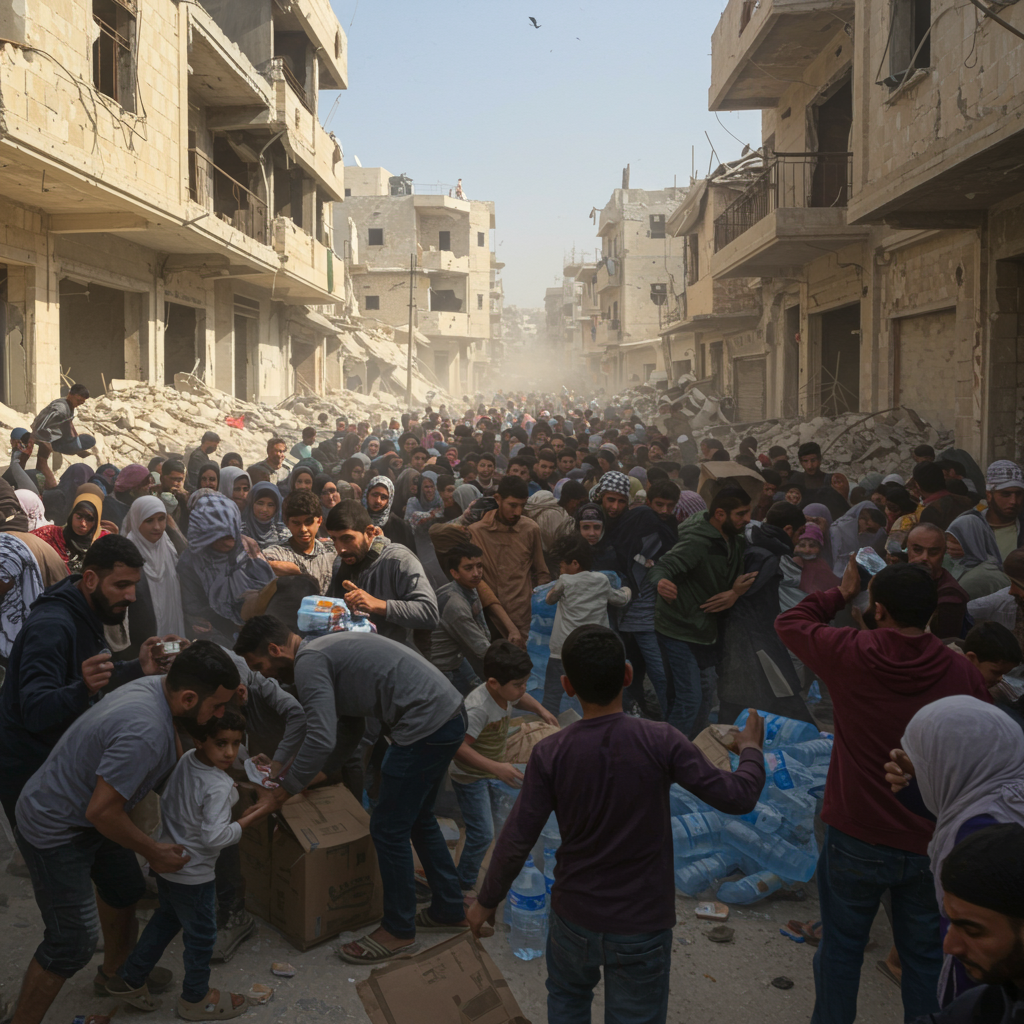In the Gaza Strip, a desperate struggle for survival has turned the simple act of seeking food into a potential death sentence. As starvation grips the besieged population, Palestinians are forced into precarious situations, often gathering in massive crowds around scarce aid deliveries, where they face gunfire, shelling, and overwhelming chaos. Palestinians have tragically dubbed this perilous reality “The Hunger Games.”
The humanitarian crisis in Gaza has reached catastrophic levels. Families report living for months with virtually no food. While a minimal “trickle” of aid has been permitted into the Strip since late May 2025, after an extended near-total blockade, it falls drastically short of meeting the basic needs of over two million people.
This scarcity, coupled with soaring market prices for what little food is available, drives starving civilians to gather, sometimes for days, at designated distribution points or to rush towards arriving aid trucks the moment they appear, hoping to secure a few kilograms of flour or canned goods. This desperate scramble, however, has become incredibly dangerous.
A Deadly Gauntlet for Sustenance
The risks are stark and well-documented. According to Gaza Civil Defense, over 400 Palestinians have been killed and more than 3,000 wounded since May 27, 2025, while simply waiting for or trying to access aid. These incidents are not isolated; survivors describe near-daily attacks at food distribution sites.
One of the deadliest incidents occurred on June 17, 2025, in Khan Younis, where Israeli forces reportedly fired tank shells, machine guns, and drones into a crowd, killing 70 people and injuring hundreds. But the violence is widespread, affecting various locations, including the critical Al-Rashid Street and areas near the Netzarim Corridor.
Eyewitnesses recount terrifying scenes of sudden artillery shelling or gunfire erupting into large, unarmed crowds of men, women, and children. Despite people falling dead or wounded around them, the desperate need for food compels many to keep pushing forward.
Stories of Loss and Impossible Choices
Beneath the grim statistics are heart-wrenching personal tragedies. Hatem Shaldan, just 19, was killed on June 11 while trying to get a bag of flour near the Netzarim Corridor. He and his brother Hamza joined a crowd rushing towards aid trucks. Artillery shells struck, separating the brothers. Hamza later found Hatem’s body, wrapped in a shroud, confirming his death from shrapnel wounds after bleeding for hours. This loss came after the death of their mother and older brother in previous attacks, highlighting the cumulative devastation faced by families.
Muhammad Abu Sharia, a 17-year-old seeking food for his family of nine, described the chaos at Al-Rashid Street the day after Hatem’s death. Despite warnings and witnessing shelling and deaths, he ran towards the trucks. He managed to grab a bag of flour but was immediately surrounded and robbed at knifepoint. He saw another man crushed under a truck. With ambulances often unable to reach the sites due to fear of strikes, the wounded and dead were transported away by donkey carts and tuk-tuks. “No one risks their life like this unless they have no other choice,” Muhammad stated. “We go because we’re starving.”
Yousef Abu Jalila, a father of 10 living in a tent after his home was destroyed, described the horrors of an artillery strike on an aid crowd on June 14, where bodies were “torn to pieces.” He witnessed limbs ripped off unarmed people seeking food. Despite the trauma and returning empty-handed, his children’s hunger means he knows he will likely have to attempt the perilous journey again.
Mohammad Al-Basyouni, 22, was shot in the back by a sniper on May 25 while trying to collect food for his sick father. He survived, but others did not. He reflected, “We knew we could die. But what choice do we have? Hunger is a killer.”
These testimonies paint a stark picture of a population trapped between the threat of starvation and the risk of violent death simply trying to avert it.
Beyond the Immediate Attack: Conditions and Control
The dangers extend beyond direct attacks. Gathering sites are often chaotic, leading to trampling and robbery. The few operational distribution points, reportedly reduced from hundreds managed by international groups to as few as four located strategically along the Netzarim Corridor and west of Rafah, are heavily guarded. Some are managed by opaque entities like the Gaza Humanitarian Foundation (GHF), reportedly with the backing of private American security contractors and Israeli soldiers.
Witnesses describe these guarded sites as resembling “concentration camps,” with armed personnel maintaining control and sometimes using verbal abuse against starving civilians. Access is sometimes contingent on biometric registration. Critics and reports suggest this system, potentially empowering criminal gangs and fragmenting authority under Israeli watch, is part of a strategy to control aid, prevent people from returning to certain areas, and ultimately engineer social collapse, further trapping the population in a cycle of desperation and dependence.
Accusations of Weaponized Aid and Dehumanization
For many, the process of seeking aid feels profoundly dehumanizing. One survivor described the crowds waiting for food as “animals waiting for the feeding lot.” The aid itself, obtained at such risk and under such conditions, is described as “wrapped in humiliation and disgrace.”
These events unfold amidst accusations from various international bodies and experts, including the ICJ and ICC, regarding potential war crimes and even “genocidal intent” on the part of some Israeli officials, citing the scale of destruction, the imposition of starvation conditions, and explicit statements calling for Gaza’s erasure or the expulsion of its population. While the international community debates accountability and some voices within Israel begin to question military actions, the devastating reality on the ground for Gazans remains: a constant struggle against death, whether from starvation or the violent consequences of seeking food.
The desperate “Hunger Games” for aid continues, a grim testament to the extreme conditions faced by starving Palestinians and the deadly gauntlet they must run for the chance to feed their families.



